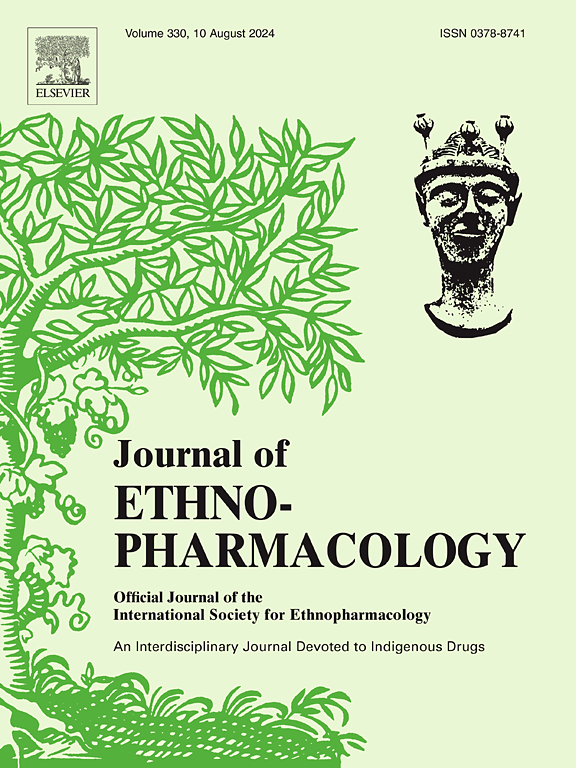复方舍舍草(白花蛇舌草方)抑制胃癌的药理学基础探讨及疗效评价。
IF 4.8
2区 医学
Q1 CHEMISTRY, MEDICINAL
引用次数: 0
摘要
民族药理学相关性:胃癌作为一种消化道恶性肿瘤,由于早期诊断率低、异质性强,仍然严重威胁着人类的健康。房舍草(白花蛇舌草方,HDF)是上海总医院的经典古方,多年来一直用于预防和治疗胃癌癌前病变。然而,缺乏系统的临床前研究。研究目的:探讨HDF的药效学物质基础,评价其在GC中的作用,阐明其潜在的药理机制。材料与方法:采用UPLC-HRMS对HDF的化学成分指纹图谱进行表征。根据HDF中鉴定出的化学成分,建立了UPLC-MS技术测定其含量的方法。通过网络药理学分析构建“化合物-靶点-疾病”网络。采用CCK8法、菌落形成法、EdU法、创面愈合法、transwell法等检测HDF对体外GC的抑制作用。采用裸鼠构建细胞源性异种移植瘤模型,在体内评价HDF抗gc的作用。Western blot技术对其潜在的药理分子机制进行初步探索和验证。结果:HDF含有1616种化学成分,分属120大类,包括槲皮素、恩格尔素、薯蓣皂苷等。成功建立了三种成分的含量检测方法,特异性、线性关系、精密度、稳定性均满足含量测定要求。HDF能显著抑制胃癌细胞的增殖、迁移和侵袭能力,诱导胃癌细胞凋亡,并在体内具有显著的抗肿瘤作用。基于网络药理学分析获得的化学成分靶点,对核心靶点进行GO和KEGG分析,发现它们参与多种经典肿瘤相关信号通路和细胞生物学过程。WB结果显示,HDF可显著降低Akt蛋白表达,增强GSK3β磷酸化和β-catenin降解,促进DKK1蛋白表达,与Wnt蛋白竞争性结合,协同降低Wnt/β-catenin通路活性。结论:HDF具有活性成分多样、治疗靶点多的优势,可抑制肿瘤相关经典信号通路Wnt/β-catenin的活性,发挥抗gc作用。本研究首次系统评价了HDF的抗GC作用,并初步解释了其药理机制,为临床应用HDF防治GC提供了坚实的理论支持。本文章由计算机程序翻译,如有差异,请以英文原文为准。

Exploration of the pharmacological substance basis and efficacy evaluation of fufang she-she-cao (Hedyotis diffusa formula) in repressing gastric cancer
Ethnopharmacological relevance
Due to the low early diagnosis rate and strong heterogeneity, gastric cancer (GC), a malignant tumor of the digestive tract, still poses a serious threat to human health. Fufang She-She-Cao (Hedyotis diffusa formula, HDF), a classic ancient prescription used in Shanghai General Hospital, has been applied to prevent and treat precancerous lesions of GC for many years. However, it lacks systematic preclinical studies.
Aim of the study
The purpose of this study is to explore the pharmacodynamic material basis of HDF, evaluate its efficacy in GC, and elucidate its underlying pharmacological mechanisms.
Materials and methods
The chemical composition fingerprint of HDF was characterized by UPLC-HRMS. Based on the chemical components identified in HDF, a content determination method was established using UPLC-MS technology. “Compounds-target-disease' network was constructed by network pharmacology analysis. The inhibitory effect of HDF on GC in vitro was detected by CCK8, colony formation assay, EdU assay, wound healing assay, transwell assay and other methods. Nude mice were used to construct a cell-derived xenograft tumor model to evaluate the anti-GC efficacy of HDF in vivo. Preliminary exploration and verification of its potential pharmacological molecular mechanism through Western blot.
Results
HDF contains 1616 chemical components, belonging to 120 categories, including Quercetin, Engelitin and Dioscin, etc. A content detection method has been successfully established for these three components, with specificity, linear relationship, precision, and stability all meeting the content determination requirements. HDF significantly inhibited the proliferation, migration, and invasion abilities of GC cells, induced apoptosis of GC cells, and also had a significant anti-tumor effect in vivo. Based on the chemical component targets obtained by network pharmacology analysis, GO and KEGG analysis of core targets showed that they were involved in multiple classic tumor-related signaling pathways and cellular biological processes. WB results showed that HDF could significantly reduce Akt protein expression, enhance GSK3β phosphorylation and degradation of β-catenin, promote DKK1 protein expression, competitively bind to Wnt protein, and collaboratively reduce the activity of Wnt/β-catenin pathway.
Conclusions
HDF has the advantages of diverse active ingredients and multiple therapeutic targets, and it could inhibit the activity of the tumor-related classic signaling pathway Wnt/β-catenin to exert anti-GC effects. This study is the first to systematically evaluate the anti-GC effect of HDF and preliminarily explain its pharmacological mechanism, providing solid theoretical support for the clinical prevention and treatment of GC with HDF.
求助全文
通过发布文献求助,成功后即可免费获取论文全文。
去求助
来源期刊

Journal of ethnopharmacology
医学-全科医学与补充医学
CiteScore
10.30
自引率
5.60%
发文量
967
审稿时长
77 days
期刊介绍:
The Journal of Ethnopharmacology is dedicated to the exchange of information and understandings about people''s use of plants, fungi, animals, microorganisms and minerals and their biological and pharmacological effects based on the principles established through international conventions. Early people confronted with illness and disease, discovered a wealth of useful therapeutic agents in the plant and animal kingdoms. The empirical knowledge of these medicinal substances and their toxic potential was passed on by oral tradition and sometimes recorded in herbals and other texts on materia medica. Many valuable drugs of today (e.g., atropine, ephedrine, tubocurarine, digoxin, reserpine) came into use through the study of indigenous remedies. Chemists continue to use plant-derived drugs (e.g., morphine, taxol, physostigmine, quinidine, emetine) as prototypes in their attempts to develop more effective and less toxic medicinals.
 求助内容:
求助内容: 应助结果提醒方式:
应助结果提醒方式:


